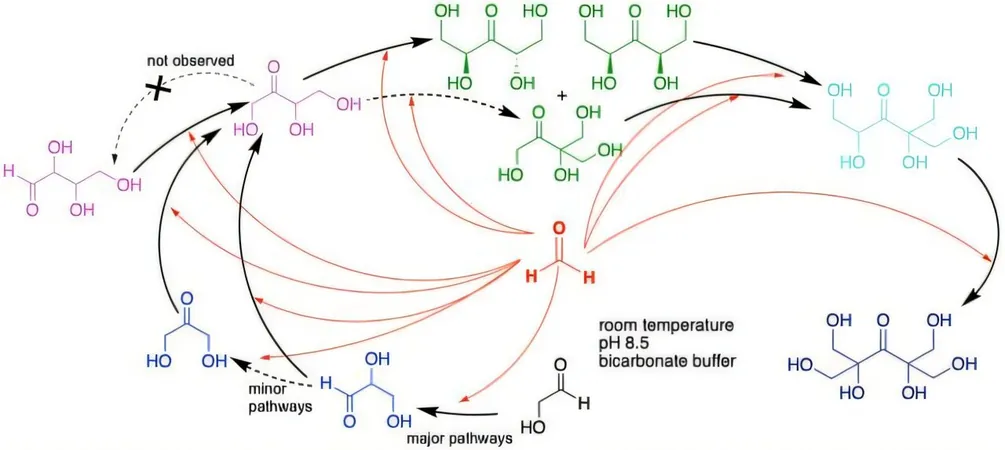
Shocking New Insights Challenge Theory of Life's First Sugars!
2025-04-30
Author: Jia
The origins of life on Earth just took an unexpected turn! For decades, scientists believed that ribose, a sugar critical to RNA and life itself, formed spontaneously in Earth's early, turbulent environment. However, a groundbreaking study by scientists at Scripps Research and Georgia Institute of Technology is turning this theory on its head.
The Formose Reaction: A Longstanding Hypothesis Under Fire
Previously, the widely accepted "formose reaction" suggested that ribose could emerge from the spontaneous reactions of formaldehyde molecules. But new research published in the journal *Chem* reveals that this reaction primarily produces branched sugars, not the linear sugars essential to life like ribose.
"The notion that the formose reaction could serve as a source for ribose needs serious reassessment," said Ramanarayanan Krishnamurthy, the study's lead author and a chemistry professor at Scripps Research. He emphasized the need to explore alternative models to better understand how these fundamental sugar molecules appeared on our planet.
A Closer Look at the Formose Reaction's Complexity
First stumbled upon in 1861, the formose reaction has since dominated theories regarding prebiotic sugar formation. The process involves formaldehyde molecules reacting in a complex and often chaotic manner to create larger molecules, forming a mixture that changes color spectacularly as it progresses, almost like caramelizing sugar.
However, Krishnamurthy points out that this reaction is messy and lacks precision. If ribose is indeed formed, it’s overshadowed by countless other compounds created in the mixture. The goal of the new research was to visualize and control the reaction better.
A Game-Changer: Testing Under Mild Conditions
Typically conducted under high heat and very basic conditions, the scientists chose to simulate milder, more Earth-like conditions—room temperature and a pH of about 8. Utilizing advanced nuclear magnetic resonance (NMR) spectroscopy, they meticulously monitored the sugar production over several days.
The findings were revelatory. Even in these gentler conditions, the mixture produced predominantly branched sugars, reinforcing the assertion that the formose reaction cannot adequately explain the origins of linear sugars vital for life.
Implications for Biofuel Production
While this research raises significant doubts about the formose reaction's role in sugar formation, it shines a light on potential applications in the biofuel industry. Krishnamurthy notes, "We discovered that milder conditions can yield cleaner production of branched sugars, which are in demand for green fuel solutions."
A Call for New Perspectives
This study doesn't close the chapter on the origins of life but rather opens up new avenues for exploration. Krishnamurthy encourages researchers to rethink the role of the formose reaction and consider fresh possibilities for uncovering how the first sugar molecules emerged on Earth.
"Our goal was to highlight the challenges in using the formose reaction for prebiotic sugar synthesis, but we’re not claiming this is the final word. We hope our findings motivate new ideas and solutions," Krishnamurthy stated. Stay tuned as the quest to unravel the mysteries of life's beginnings continues!





 Brasil (PT)
Brasil (PT)
 Canada (EN)
Canada (EN)
 Chile (ES)
Chile (ES)
 Česko (CS)
Česko (CS)
 대한민국 (KO)
대한민국 (KO)
 España (ES)
España (ES)
 France (FR)
France (FR)
 Hong Kong (EN)
Hong Kong (EN)
 Italia (IT)
Italia (IT)
 日本 (JA)
日本 (JA)
 Magyarország (HU)
Magyarország (HU)
 Norge (NO)
Norge (NO)
 Polska (PL)
Polska (PL)
 Schweiz (DE)
Schweiz (DE)
 Singapore (EN)
Singapore (EN)
 Sverige (SV)
Sverige (SV)
 Suomi (FI)
Suomi (FI)
 Türkiye (TR)
Türkiye (TR)
 الإمارات العربية المتحدة (AR)
الإمارات العربية المتحدة (AR)